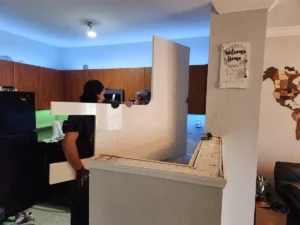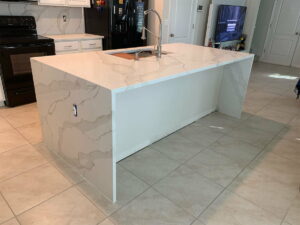Choosing the best countertop materials for your kitchen has a significant impact on both style and functionality. From reflecting personal taste to standing up against daily wear and tear, kitchen countertop materials play a vital role in the kitchen’s overall design. Over the past several decades, countertops have undergone a remarkable evolution—moving from the humble laminate countertops of the mid-20th century to the sophisticated granite countertops and quartz countertops we see in many modern homes today.
Whether you’re renovating an older kitchen or designing a brand-new space, understanding this evolution can guide you in making an informed decision that balances cost, durability, and aesthetics. Below, we’ll explore the historical shifts in countertop preferences, examine what drove these changes, and look ahead to future trends that might influence the modern kitchen surfaces of tomorrow.
Early Countertop Materials (1950s–1980s)
The Rise of Laminate Countertops
In the mid-20th century (particularly the 1950s through the 1980s), laminate countertops reigned supreme. Known for their affordability and versatile design options, laminates quickly took over American kitchens. They were often marketed as a modern, innovative choice, especially as post-war manufacturing ramped up, making mass-produced materials more accessible to a growing middle class.
- Affordability: Laminate surfaces, made by bonding a thin decorative layer of printed paper or plastic to particleboard, cost a fraction of what other materials did at the time.
- Wide range of designs: Homeowners could choose from numerous patterns and colors, making laminate an excellent option for customizing a kitchen’s look.
- Easy installation: Light and relatively straightforward to cut and install, laminates were an appealing choice for DIY enthusiasts and contractors alike.
Despite these advantages, laminate countertops came with some notable drawbacks:
- Low resistance to heat and moisture: The thin plastic layer could blister or peel when exposed to extreme heat, and the particleboard core was prone to swelling if water seeped in through seams or scratches.
- Susceptibility to wear: Over time, laminates were more likely to develop scratches, chips, and signs of wear, reducing their lifespan and overall appearance.
Other Materials of the Era
While laminate countertops dominated, a few alternatives remained popular in specific regions or design contexts:
- Wood: Butcher block countertops, typically made of maple or oak, provided a warm, rustic look. However, wood required regular sealing and maintenance to avoid damage from moisture and bacteria.
- Tile: Ceramic tile countertops allowed for creative designs and were relatively heat-resistant. Yet, the grout lines made them less appealing in terms of ease of cleaning and overall upkeep.
These early materials laid the groundwork for kitchen countertop materials that balanced cost with style. However, by the late 1980s, many homeowners began to look for more durable countertops and gradually turned away from laminates.

Shift to More Durable Materials (1990s–Early 2000s)
Moving Away from Laminate
By the 1990s, consumer tastes began to shift toward stronger and more visually appealing materials. A combination of factors contributed to this change:
- Higher disposable incomes: As many households experienced increased economic stability, they had the budget to invest in higher-end kitchen renovations.
- Media influence: Home improvement shows, magazines, and the rise of the internet inspired homeowners to seek out luxurious and unique designs.
- Technological advancements: Improved quarrying and stone-cutting technology made natural stone more accessible and cost-effective.
As a result, materials like granite and marble became increasingly sought-after, and homeowners became more willing to splurge on durable countertops that offered both elegance and long-term value.
The Rise of Natural Stone Countertops
Granite Countertops
Granite countertops were among the first natural stone surfaces to gain widespread popularity. Granite’s unique patterns and color variations quickly became a hallmark of a high-end kitchen. Homeowners were (and still are) drawn to its:
- Unmatched elegance: Each granite slab features one-of-a-kind veining and coloration, adding a natural, luxurious look.
- Durability: Granite is heat-resistant and less prone to scratches compared to many other options.
- Longevity: When properly sealed and maintained, granite can last for decades without losing its luster.
Although granite countertops commanded a higher price than laminates, many homeowners viewed them as a worthy investment, boosting the property’s resale value and giving the kitchen a modern, timeless appeal.
Marble Countertops
While not as durable as granite—particularly when it comes to stains and etching from acidic substances—marble countertops also made a significant impact during this era. Marble’s white, veined surface became a symbol of luxury, often featured in upscale homes and in areas where a more classic or European-inspired design was desired. However, the higher maintenance needs of marble made it a less common choice than granite for busy households.
Factors Behind the Shift
Several industry and consumer trends propelled this move away from laminates and toward natural stone:
- Improved stone processing: Innovations in cutting, polishing, and shipping meant that homeowners could obtain granite countertops and marble countertops more readily.
- Increased consumer awareness: The home improvement boom of the 1990s and early 2000s introduced more homeowners to the concept of using premium materials that could deliver both aesthetic value and durability.
- Emphasis on kitchen design: As open-concept layouts became more common, the kitchen took on a focal role in home design, motivating homeowners to invest in eye-catching, high-end surfaces.
By the early 2000s, natural stone had firmly established itself as a leading choice, yet the evolution of kitchen countertop materials was far from over.
Modern Countertop Materials (2010s–Present)
Quartz Countertops: The Game Changer
If granite countertops dominated kitchen design in the late 1990s and early 2000s, quartz countertops have arguably taken center stage in the 2010s and beyond. Quartz (also known as “engineered stone”) is manufactured by combining crushed quartz with resins and pigments, resulting in a non-porous, highly durable countertop surface. Here’s why it’s become one of the most popular and best countertop materials for modern kitchens:
- Low Maintenance: Since engineered quartz is non-porous, it doesn’t require sealing, making it resistant to stains, bacteria, and moisture.
- Consistent Patterns: Unlike natural stone, quartz can be engineered to have a uniform look and color, appealing to homeowners who prefer a consistent, contemporary style.
- Wide Color Range: Manufacturers can add various pigments to achieve almost any color or pattern, from natural stone replicas to more playful, modern designs.
- Durability: Quartz is heat-resistant and scratch-resistant, although caution is advised when placing extremely hot pots or cutting directly on the surface.
Other Trending Materials
While quartz countertops dominate modern kitchens, several other materials have gained traction in recent years, each offering unique benefits:
- Concrete: A popular choice for industrial or minimalist designs, concrete can be customized with different pigments and finishes. However, it can be prone to cracking and does require sealing.
- Stainless Steel: Once primarily found in commercial kitchens, stainless steel countertops are now favored for their sleek, modern look and extreme resistance to heat and stains. Fingerprints and scratches can be a downside for some homeowners.
- Recycled Surfaces: Eco-friendly countertops made from recycled glass, paper, or composite materials have risen in popularity. They offer an environmentally conscious option without sacrificing style.
- Solid Surface: Brands like Corian offer seamless countertops that can be shaped to include integrated sinks and backsplashes. These surfaces are relatively easy to maintain but can be vulnerable to heat and scratches if not carefully used.
Embracing Modern Kitchen Surfaces
Thanks to continued innovations, homeowners now have access to a vast array of modern kitchen surfaces, each with varying levels of durability, maintenance requirements, and aesthetic appeal. The focus on customization, environmental responsibility, and longevity has driven manufacturers to develop ever more specialized countertop materials.

Future Trends in Kitchen Countertops
Looking ahead, several developing trends and emerging materials might shape tomorrow’s kitchens:
- Sustainable and Eco-Conscious Design
- Homeowners increasingly value green materials, leading manufacturers to explore lower-impact extraction methods and recycled composites.
- Zero-waste manufacturing processes and the use of post-consumer recycled content will likely become more prevalent, offering a blend of style and sustainability.
- Smart and Integrated Countertops
- Technological advancements could soon integrate wireless charging, LED lighting, and even interactive touchscreens directly into countertops.
- These smart surfaces would not only serve practical functions but also enhance the modern, innovative feel of kitchens in the digital age.
- Enhanced Durability and Innovation
- New composite materials are under development that combine stone aggregates with novel binders, promising even greater resistance to heat, scratches, and chemical damage.
- Self-healing surfaces might become a reality, allowing countertops to repair minor scratches or surface imperfections without requiring professional intervention.
- Biophilic and Natural Materials
- There is growing interest in designs that foster a stronger connection to nature. This might mean an increased emphasis on wood, bamboo, or stone surfaces that highlight the natural veining and textures.
- Material treatments that preserve natural elements—like live-edge wood slabs or unpolished stone—could find a niche among homeowners seeking an organic feel in their kitchen.
- Customization Options
- As technology progresses, 3D printing and custom molds might become more common, allowing homeowners to specify the exact shape, pattern, or texture of their countertop.
- The result could be truly unique surfaces tailored to fit specific design visions or functional needs.
While granite countertops and quartz countertops may continue to dominate, these emerging trends suggest an exciting evolution that caters to diverse design philosophies and priorities.
Conclusion
From the affordable yet easily damaged laminate countertops of the mid-20th century to the sleek and durable countertops of today, the evolution of kitchen countertop materials has been driven by advancements in technology, shifting consumer demands, and a broader cultural emphasis on quality and design. Early kitchens in the 1950s and 1960s showcased laminate’s affordability and design flexibility. By the 1990s and early 2000s, natural stone options—particularly granite countertops—became the go-to choice for homeowners desiring both elegance and long-term value. In the modern era, quartz countertops stand out for their combination of low maintenance, durability, and design versatility.
With future trends pointing toward sustainability, technological integration, and further customization, it’s clear that the realm of kitchen countertop materials will continue to innovate. For homeowners, the main takeaway is that a kitchen countertop is not merely a functional surface but an investment that can transform the overall look and feel of the home.
Recommendations for Choosing the Right Countertop
- Consider Your Budget:
- Laminate and tile are cost-effective but may require more frequent replacement.
- Granite and quartz cost more up front but often pay off in durability and resale value.
- Think About Lifestyle and Maintenance:
- If you’re a busy family that cooks frequently, opting for durable countertops like quartz, granite, or stainless steel might be wise.
- For those who prioritize design experimentation or enjoy changing décor regularly, more affordable materials might be preferable.
- Match Your Design Aesthetics:
- Granite countertops provide a natural, varied look, while quartz countertops offer consistent patterns and colors.
- If your style leans industrial, consider concrete or stainless steel. For a warm, rustic vibe, explore wood or recycled composite options.
- Long-Term Value:
- Well-maintained stone or quartz surfaces can significantly enhance your home’s market appeal.
- Consider the return on investment: a high-quality countertop often draws buyers and creates a lasting impression.
- Environmental Impact:
- If sustainability is a concern, research eco-friendly materials like recycled glass, composite stone, or responsibly sourced wood.
- Aim for suppliers who emphasize ethical quarrying, energy-efficient production, and minimal waste.
By reflecting on the evolution of countertop materials—from laminate to natural stone and beyond—you can make an informed decision that fits your budget, design preferences, and lifestyle needs. Today’s modern kitchen surfaces offer a wealth of innovative, high-performance options, and emerging trends promise even more exciting possibilities on the horizon. Ultimately, understanding both the past and the future of kitchen countertop materials can help you create a functional and beautiful kitchen that stands the test of time.





